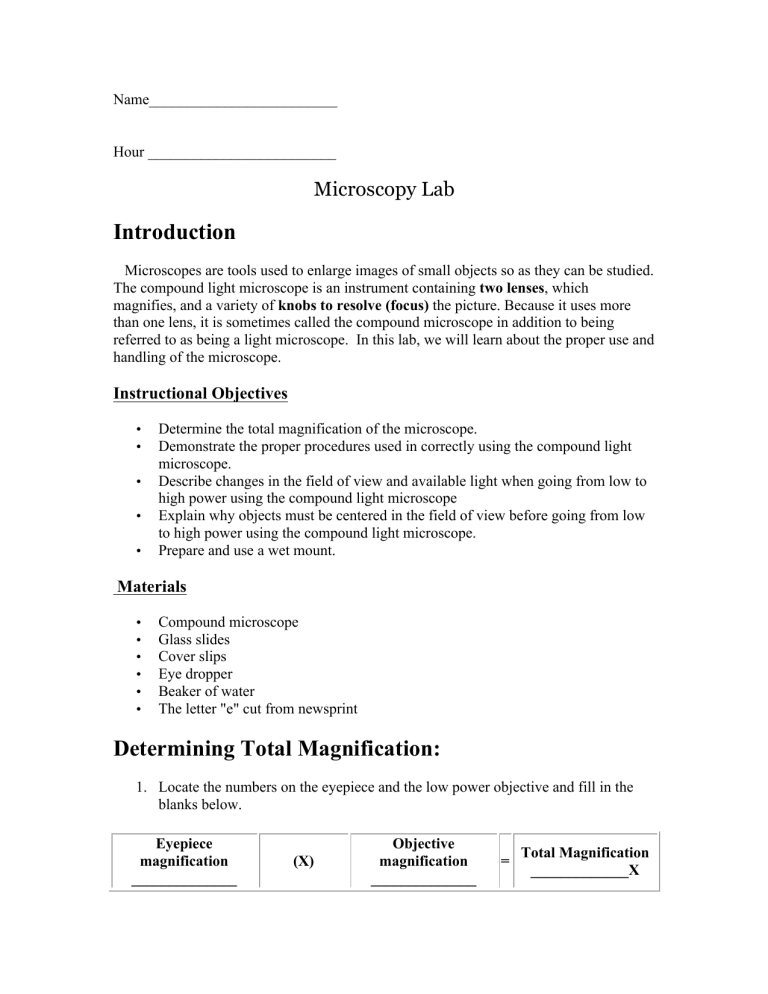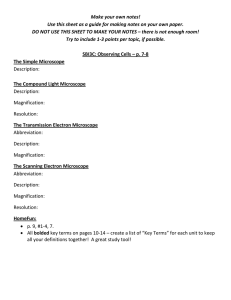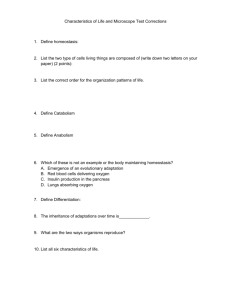
Name_________________________ Hour _________________________ Microscopy Lab Introduction Microscopes are tools used to enlarge images of small objects so as they can be studied. The compound light microscope is an instrument containing two lenses, which magnifies, and a variety of knobs to resolve (focus) the picture. Because it uses more than one lens, it is sometimes called the compound microscope in addition to being referred to as being a light microscope. In this lab, we will learn about the proper use and handling of the microscope. Instructional Objectives • • • • • Determine the total magnification of the microscope. Demonstrate the proper procedures used in correctly using the compound light microscope. Describe changes in the field of view and available light when going from low to high power using the compound light microscope Explain why objects must be centered in the field of view before going from low to high power using the compound light microscope. Prepare and use a wet mount. Materials • • • • • • Compound microscope Glass slides Cover slips Eye dropper Beaker of water The letter "e" cut from newsprint Determining Total Magnification: 1. Locate the numbers on the eyepiece and the low power objective and fill in the blanks below. Eyepiece magnification ______________ (X) Objective magnification ______________ = Total Magnification _____________X 2. Do the same for the high power objective. Eyepiece magnification ______________ Objective magnification ______________ (X) = Total Magnification _____________X 3. Write out the rule for determining total magnification of a compound microscope. ___________________________________________________ Observing the Letter “e” PROCEDURE 1. Cut out the letter “e” and place it on the slide face up. 2. Add a drop of water to the slide. 3. Place the cover slip on top of the “e” and drop of water at a 45-degree angle and lower. Draw what is on the slide in Figure 1. 4. Place the slide on the stage and view in low power (4x). Center the “e” in your field of view. Draw what you see in Figure 2. 5. Move the slide to the left, what happens? Move the slide to the right, what happens? Up? Down? 6. View the specimen in high power (10x). Use the fine adjustment only to focus. Draw what you see in Figure 3. Data: Part 1- The letter “e” Figure 1: Drawing of the letter “e” on the slide. (half page) Figure 1 Figure 2: Drawing of the letter “e” in low power (4x). (half page) Figure 2 Figure 3: Drawing of the letter “e” in high power (10x) (half page) Figure 3 ANALYSIS: 1. How does the letter “e” as seen through the microscope differ from the way an “e” normally appears? ______________________________________________________ ______________________________________________________ 2. When you move the slide to the left, in what direction does the letter “e” appear to move? When you move it to the right? Up? Down? ______________________________________________________ ______________________________________________________ 3. How does the ink appear under the microscope compared to normal view? ______________________________________________________ ______________________________________________________ 4. Why does a specimen placed under the microscope have to be thin? ______________________________________________________ ______________________________________________________ ______________________________________________________ Observing Prepared Slides PROCEDURE 1. Obtain a prepared slide from your instructor. 2. Make sure to obtain clear focus on LOW POWER. 3. Record and draw your observations in the figures (4 – 7) provided for each of the slides of your instructor’s choice. Figure 4 (4x) Figure 5 (10x) Figure 6 (4x) Figure 7 (10x) 1. NAME OF ORGANISMS OBSERVED:___________________________________ 2. NAME OF ORGANISMS OBSERVED:___________________________________ ANALYSIS: 1. What did you notice that was the same when observing the letter “e” compared to the prepared slides? ______________________________________________________ ______________________________________________________ ______________________________________________________ 2. What happened when you changed the magnification from low to high power when observing these types of cells? Use details when describing your observations. ______________________________________________________ ______________________________________________________ ______________________________________________________ 3. What are some parts of the cell that you can observe on high power? ______________________________________________________ ______________________________________________________ ______________________________________________________




